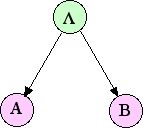模板:NumBlk
| 本模板使用以下模板样式: |
| 此模板使用Lua语言: |
此模板可用于编号数学公式与化学式。可和{{EquationRef}}同时使用,用于加入来源引用。
![]() 警告:当此模板与前导冒号
警告:当此模板与前导冒号:、前导星号*或前导井字号#一起使用时,可能会导致lint错误(英文说明)。更多信息,请参阅§ 通过参数|2=以外的方式做缩进、§ 无序清单和§ 有序清单。
参数[编辑]
参数|1=、|2=和|3=是必须的。另外还有可选参数|Attr=、|RawN=、|Cl=、|LnSty=和|Border=。
|1=:设置缩进。放置的冒号:越多,块缩进的层数就越多。若不需缩进,此参数应赋空值。|2=:内容。|3=:编号。|Attr=- 指定此模板最外层元素的属性,可以指定多个属性。此参数之默认值为
style="margin-left: {{#expr:1.6 * 縮排的層數}}em;",其中缩进的层数是根据|1=所推算出来,故此参数的默认值决定了模板的缩进。一旦设置了此参数,默认值将由用户所给之值取代,因此需另外自行给予适当的设置以得到预期的缩进效果。因为class属性已被此模板所使用,在此参数中直接指定class属性可能会造问题。class属性应通过|Cl=做设置。
- 指定此模板最外层元素的属性,可以指定多个属性。此参数之默认值为
|RawN=- 赋予之值在除去字符串首尾空白字符后若不是空串则此参数生效,否则此参数失效。当此参数生效时,移除编号和括号的格式。
|Cl=- 此参数之值会被加进模板最外层元素的
class属性里,所以此参数需符合class属性的语法,是一个以空格分隔的class列表。class属性允许CSS通过class选择器(class selector)来设置样式。此模板所使用的模板样式包含了以下classes:numblk- 主要作为识别{{NumBlk}}模板的用途,此class会被自动加进模板最外层元素的
class属性里。 numblk-raw-n- 当
|RawN=生效时,此class会被自动加进模板最外层元素的class属性里。模板最外层元素的class属性里包含此class时,模版会被调整为|RawN=生效时其说明所描述的样式。 numblk-border- 当
|Border=生效时,此class会被自动加进模板最外层元素的class属性里。模板最外层元素的class属性里包含此class时,模版会被调整为|Border=生效时其说明所描述的样式。
- 此参数之值会被加进模板最外层元素的
|LnSty=:设置线样式。|Border=- 赋予之值在除去字符串首尾空白字符后若不是空串则此参数生效,否则此参数失效。当此参数生效时,将显示边框。
示例[编辑]
可生成HTML的公式[编辑] | ||||||||||
|---|---|---|---|---|---|---|---|---|---|---|
|
|
| |||||||||
|
|
| |||||||||
|
|
| |||||||||
|
|
| |||||||||
|
|
| |||||||||
缩进[编辑] | ||||||||||
|
|
| |||||||||
|
|
| |||||||||
|
|
| |||||||||
|
|
| |||||||||
公式编号格式[编辑] | ||||||||||
|
|
| |||||||||
|
|
| |||||||||
|
|
| |||||||||
|
|
| |||||||||
|
|
| |||||||||
|
|
| |||||||||
|
|
| |||||||||
线样式[编辑] | ||||||||||
|
|
| |||||||||
|
|
| |||||||||
|
|
| |||||||||
|
|
| |||||||||
|
|
| |||||||||
|
|
| |||||||||
|
|
| |||||||||
通过参数
| ||||||||||
以下的方程式
:<math>3x+2y-z=1</math>
::<math>2x-2y+4z=-2</math>
:::<math>-2x+y-2z=0</math>
形成三個方程式的方程組。
|
以下的方程式 形成三个方程式的方程组。 | |||||||||
以下的方程式
:{{NumBlk||<math>3x+2y-z=1</math>|1}}
::{{NumBlk||<math>2x-2y+4z=-2</math>|2}}
:::{{NumBlk||<math>-2x+y-2z=0</math>|3}}
形成三個方程式的方程組。
|
||||||||||
以下的方程式
<dl><dd>
{{NumBlk||<math>3x+2y-z=1</math>|1}}
<dl><dd>
{{NumBlk||<math>2x-2y+4z=-2</math>|2}}
<dl><dd>
{{NumBlk||<math>-2x+y-2z=0</math>|3}}
</dd></dl>
</dd></dl>
</dd></dl>
形成三個方程式的方程組。
|
以下的方程式
形成三个方程式的方程组。 | |||||||||
以下的方程式
<div style="margin-left: 1.6em;">
{{NumBlk||<math>3x+2y-z=1</math>|1}}
<div style="margin-left: 1.6em;">
{{NumBlk||<math>2x-2y+4z=-2</math>|2}}
<div style="margin-left: 1.6em;">
{{NumBlk||<math>-2x+y-2z=0</math>|3}}
</div>
</div>
</div>
形成三個方程式的方程組。
|
以下的方程式
形成三个方程式的方程组。 | |||||||||
以下的方程式
<div style="margin-left: calc(1.6em * 1);">
{{NumBlk||<math>3x+2y-z=1</math>|1}}
</div>
<div style="margin-left: calc(1.6em * 2);">
{{NumBlk||<math>2x-2y+4z=-2</math>|2}}
</div>
<div style="margin-left: calc(1.6em * 3);">
{{NumBlk||<math>-2x+y-2z=0</math>|3}}
</div>
形成三個方程式的方程組。
|
以下的方程式
形成三个方程式的方程组。 | |||||||||
无序清单[编辑] | ||||||||||
* <math>3x+2y-z=1</math>
* <math>2x-2y+4z=-2</math>
* <math>-2x+y-2z=0</math>
|
| |||||||||
* {{NumBlk||<math>3x+2y-z=1</math>|1}}
* {{NumBlk||<math>2x-2y+4z=-2</math>|2}}
* {{NumBlk||<math>-2x+y-2z=0</math>|3}}
|
||||||||||
{{Bulleted list
|1=<div style="display: inline-block; width: 100%; vertical-align: middle;">{{NumBlk||<math>3x+2y-z=1</math>|Eq. 1}}</div>
|2=<div style="display: inline-block; width: 100%; vertical-align: middle;">{{NumBlk||<math>2x-2y+4z=-2</math>|Eq. 2}}</div>
|3=<div style="display: inline-block; width: 100%; vertical-align: middle;">{{NumBlk||<math>-2x+y-2z=0</math>|Eq. 3}}</div>
}}
|
| |||||||||
{{Bulleted list
|1=<div style="display: inline-table; width: 100%; vertical-align: middle;">{{NumBlk||<math>3x+2y-z=1</math>|Eq. 1}}</div>
|2=<div style="display: inline-table; width: 100%; vertical-align: middle;">{{NumBlk||<math>2x-2y+4z=-2</math>|Eq. 2}}</div>
|3=<div style="display: inline-table; width: 100%; vertical-align: middle;">{{NumBlk||<math>-2x+y-2z=0</math>|Eq. 3}}</div>
}}
|
| |||||||||
有序清单[编辑] | ||||||||||
# <math>3x+2y-z=1</math>
# <math>2x-2y+4z=-2</math>
# <math>-2x+y-2z=0</math>
|
| |||||||||
# {{NumBlk||<math>3x+2y-z=1</math>|1}}
# {{NumBlk||<math>2x-2y+4z=-2</math>|2}}
# {{NumBlk||<math>-2x+y-2z=0</math>|3}}
|
||||||||||
{{Ordered list
|1=<div style="display: inline-block; width: 100%; vertical-align: middle;">{{NumBlk||<math>3x+2y-z=1</math>|Eq. 1}}</div>
|2=<div style="display: inline-block; width: 100%; vertical-align: middle;">{{NumBlk||<math>2x-2y+4z=-2</math>|Eq. 2}}</div>
|3=<div style="display: inline-block; width: 100%; vertical-align: middle;">{{NumBlk||<math>-2x+y-2z=0</math>|Eq. 3}}</div>
}}
|
| |||||||||
{{Ordered list
|1=<div style="display: inline-table; width: 100%; vertical-align: middle;">{{NumBlk||<math>3x+2y-z=1</math>|Eq. 1}}</div>
|2=<div style="display: inline-table; width: 100%; vertical-align: middle;">{{NumBlk||<math>2x-2y+4z=-2</math>|Eq. 2}}</div>
|3=<div style="display: inline-table; width: 100%; vertical-align: middle;">{{NumBlk||<math>-2x+y-2z=0</math>|Eq. 3}}</div>
}}
|
| |||||||||
边框[编辑] | ||||||||||
<!-- 未指定 LnSty -->
{{NumBlk|:|<math>y=ax+b</math>|Eq. 3|Border=1}}
|
| |||||||||
<!-- 指定 LnSty -->
{{NumBlk|:|<math>y=ax+b</math>|Eq. 3|LnSty=0.7em solid #e500e5|Border=1}}
|
| |||||||||
Positioning relative to surrounding images[编辑]
Numbered blocks should be able to be placed around images that take up space on the left or right side of the screen. To ensure numbered block has access to the entire line, consider using a {{clear}}-like template.
To illustrate, consider the example:
[[Image:Bnet_fan2.png|frame|right|Fig.1: Bayesian Network representation of Eq.(6)]]
[[Image:Bnet_fan2.png|frame|left|Fig.1: Bayesian Network representation of Eq.(6)]]
<br><br>A Bayesian network (or a belief network) is a probabilistic graphical model that represents a set of
variables and their probabilistic independencies. For example, a Bayesian network could represent the
probabilistic relationships between diseases and symptoms. Given symptoms, the network can be used to compute
the probabilities of the presence of various diseases.
{{NumBlk|1=:|2=<math>
P(a, b, \lambda) = P(a| \lambda) P(b | \lambda) P(\lambda)\,
</math>,|3='''Eq.(6)'''|RawN=.}}

A Bayesian network (or a belief network) is a probabilistic graphical model that represents a set of
variables and their probabilistic independencies. For example, a Bayesian network could represent the
probabilistic relationships between diseases and symptoms. Given symptoms, the network can be used to compute
the probabilities of the presence of various diseases.
| , | Eq.(6) |
If it is desirable for the numbered block to span the entire line, a {{clear}} should be placed before it.
[[Image:Bnet_fan2.png|frame|right|Fig.1: Bayesian Network representation of Eq.(6)]]
[[Image:Bnet_fan2.png|frame|left|Fig.1: Bayesian Network representation of Eq.(6)]]
<br><br>A Bayesian network (or a belief network) is a probabilistic graphical model that represents a set of
variables and their probabilistic independencies. For example, a Bayesian network could represent the
probabilistic relationships between diseases and symptoms. Given symptoms, the network can be used to compute
the probabilities of the presence of various diseases.
{{clear}}
{{NumBlk|1=:|2=<math>
P(a, b, \lambda) = P(a| \lambda) P(b | \lambda) P(\lambda)\,
</math>,|3='''Eq.(6)'''|RawN=.}}

A Bayesian network (or a belief network) is a probabilistic graphical model that represents a set of
variables and their probabilistic independencies. For example, a Bayesian network could represent the
probabilistic relationships between diseases and symptoms. Given symptoms, the network can be used to compute
the probabilities of the presence of various diseases.
| , | Eq.(6) |
Table caveat[编辑]
Because {{NumBlk}} is implemented as a table, putting {{NumBlk}} within a table yields a nested table. Due to a bug in Mediawiki's handling of nested tables, {{NumBlk}} must be used carefully in this case. In particular, when indentation for the outer table is desired, use explicit <dl><dd> and </dd></dl> tags for indentation instead of a leading colon (:).
For example,
<dl><dd>
{|
|<math>(f * g)[n]\,</math>
|{{NumBlk||<math>\stackrel{\mathrm{def}}{=}\sum_{m=-\infty}^{\infty} f[m]\cdot g[n - m]\,</math>|
3=<span style="color:darkred;">'''(Eq.1)'''</span>|RawN=.}}
|-
|
|<math>= \sum_{m=-\infty}^{\infty} f[n-m]\cdot g[m].\,</math> ([[Convolution#Commutativity|commutativity]])
|}
</dd></dl>
produces
-
(Eq.1) (commutativity)
which shows how the outer <dl><dd> and </dd></dl> tags give the same indentation as a single colon (:) preceding the table should.
For another example,
<dl><dd>
<dl><dd>
{|
|-
|The first parameter for indentation still works when used inside table.
{{NumBlk|::::|<math>ax^2+bx+c=0</math>|Level 4}}
{{NumBlk|:::|<math>ax^2+bx+c=0</math>|Level 3}}
{{NumBlk|::|<math>ax^2+bx+c=0</math>|Level 2}}
{{NumBlk|:|<math>ax^2+bx+c=0</math>|Level 1}}
{{NumBlk||<math>ax^2+bx+c=0</math>|Level 0}}
|-
|}
</dd></dl>
</dd></dl>
produces
-
-
The first parameter for indentation still works when used inside table. Level 4 Level 3 Level 2 Level 1 Level 0
-
which uses two sets of explicit tags to give the same indentation as two colons (::).
| 上述文档嵌入自Template:NumBlk/doc。 (编辑 | 历史) 编者可以在本模板的沙盒 (编辑 | 差异)和测试样例 (编辑)页面进行实验。 请在/doc子页面中添加分类。本模板的子页面。 |











![{\displaystyle (f*g)[n]\,}](https://wikimedia.org/api/rest_v1/media/math/render/svg/21b35630bbf1ce4962d17f232b71b4a746cd6c5a)
![{\displaystyle {\stackrel {\mathrm {def} }{=}}\sum _{m=-\infty }^{\infty }f[m]\cdot g[n-m]\,}](https://wikimedia.org/api/rest_v1/media/math/render/svg/341c36b82ecf37616a2c8547b22460162815d235)
![{\displaystyle =\sum _{m=-\infty }^{\infty }f[n-m]\cdot g[m].\,}](https://wikimedia.org/api/rest_v1/media/math/render/svg/fc8b45d23504b0d2ef575c406abe8e95c5e9c3b9)